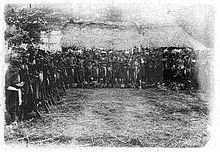Headhunting

As a headhunting killing one calls a person to whose skull to capture the trophy. Today there are only very few indigenous peoples who hunt the head in order to magically harness the energy potential assumed in the skull. Headhunting is associated with cannibalism only in a few cases and is particularly widespread in Southeast Asia , Melanesia and the northwestern lowlands of South America.
history
Headhunting is one of the oldest rituals and was widespread all over the world. Stories of drinking from skulls have also been passed on in Europe . Headhunting was an established tradition in the Celtic warrior culture during the Iron Age . At that time, head trophies were a common part of the bridle of Celtic riders. In China and Japan , heads were collected as war trophies. Headhunting was still practiced among some peoples in Southeast Asia , West Africa , South America , Melanesia and Taiwan until the 20th century .
The Dayak on Borneo are among the most famous peoples in Southeast Asia . Headhunting among the formerly so-called Alfurs on the Moluccas is more of a speculative attribution, on the other hand headhunting was widespread in New Guinea until the middle of the 20th century and was practiced particularly aggressively among the Marind-anim , Sawi , Asmat and the Iatmul . A slit drum ( garamut ) was often used in rituals involving skull cults and headhunting . In a ceremony observed among the Asmat in 1952, the beheading of two women was performed.
In the central mountains on the northern Philippine island of Luzon , several peoples were headhunters, among them the Igorot and Ifugao . On returning from a successful headhunt, an ensemble with several ceremonial flat gongs played gangsa for the men .
The Naga (India), Garo (India / Bangladesh), Ekoi (West Africa) and Shuar (South America) also hunted heads .
South American headhunters often shrunk their trophies into shrunken heads . A special form of headhunting is scalping (North America, Europe).
Sense and meaning
Headhunting was used to deter and demoralize the enemy or to increase the social reputation of the person who killed.
In some cultures it was believed that the life force of the victim suspected in the head should pass to the headhunter. The American anthropologist Weston La Barre suggested that Stone Age headhunters were primarily concerned with the brain as a supposed store of pent-up sperm , the primitive epitome of life-marrow.
In some peoples a boy had to steal a head in order to be considered a man and to be accepted into society. A marriage was only possible upon showing one or more skulls. Some peoples needed a certain number of captured heads in order to become chief .
See also
literature
- Arsenio Nicolas Jr .: Ritual Transformation and Musical Parameters. A Study of Selected Head-Hunting Rites on Southern Cordillera, Northern Luzon. (MA thesis) University of the Philippines, 1989 (English).
- Jörg Scheidt, Marc Hellstern: An over-modeled skull of the Dayak . In: K. Grundmann, Gerhard Aumüller (ed.): The Marburg Medical History Museum - Museum Anatomicum. (= Marburg city writings on history and culture, Volume 98). Marburg 2012, pp. 84–86.
- Alfried Wieczorek , Wilfried Rosendahl, Andreas Schlothauer (eds.): The cult around the head and skull. Interdisciplinary considerations on a human issue. (= Colloquium volume on the occasion of the exhibition "Skull Cult - Head and Skull in the Cultural History of Man" in the Reiss-Engelhorn-Museums Mannheim). Verlag Regionalkultur, Heidelberg et al. 2012, ISBN 978-3-89735-769-3 .
- Alfried Wieczorek, Wilfried Rosendahl (ed.): Skull cult - head and skull in the cultural history of man. Schnell + Steiner, Regensburg 2011, ISBN 978-3-7954-2454-1 .
- Hitoshi Yamada: Religious-mythological ideas among the Austronesian peoples of Taiwan. A contribution to the ethnology of East and Southeast Asia. (Dissertation) Ludwig Maximilians University, Munich 2002, pp. 234–256.
Individual evidence
- ↑ http://www.lard.net/headhunters.html
- ↑ Walter Graf: Some remarks on the slit drum understanding in New Guinea. In: Anthropos, Volume 45, Issue 4./6, July – December 1950, pp. 861–868, here p. 862
- ^ Fr. G. Zegwaard: Bamboo Breastplates and Headhunting in the Asmat: The Ao — Mapac Case. In: Pacific Arts, No. 7, January 1993, pp. 50f
- ^ Head-Hunting in Southeast Asia. Center for Southeast Asian Studies, Northern Illinois University
- ↑ a b cf. Meyers Konversationslexikon from 1888
- ^ Weston La Barre: Muelos: A Stone Age Superstition about Sexuality . New York 1984 (Columbia University Press)
